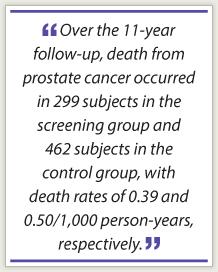Studies assessing the effect of prostate-specific antigen (PSA) testing on prostate cancer mortality have produced conflicting results, and recommendations regarding PSA screening vary among authorities. The recently published 11-year follow-up of the European Randomized Study of Screening for Prostate Cancer (ERSPC) indicates that offering PSA-based screening to a core age group of men aged 55 to 69 years at study entry is associated with a significant 21% reduction in risk of death from prostate cancer.1
Study Background
ERSPC involved 182,160 men aged 50 to 74 years at entry from eight European countries, including a core group of 162,388 men aged 55 to 69 years. Subjects were randomized to a screening group that was offered PSA-based screening or a control group that was not offered screening. The primary outcome measure was prostate cancer mortality. All-cause mortality was not an endpoint of this study, and, as expected, no difference was seen.
Over a median follow-up of 11 years in the core age group, 136,689 screening tests were performed—an average of 2.3 tests per subject with a median screening interval of 4 years. Of these tests, 16.6% were positive, and 85.9% of men with positive tests underwent prostate biopsy. A total of 6,963 prostate cancers were diagnosed in the screening group, a cumulative incidence of 9.6% (9.66 cases/1,000 person-years), and a total of 5,396 cases were diagnosed in the control group, a cumulative incidence of 6.0% (5.95/1,000 person-years). The rate ratio in the screening group was 1.63, with a rate difference of 3.71 cases/1,000 person-years. The excess incidence in the screening group was largely attributable to small, well-differentiated tumors. Advanced tumors (T3, T4, or distant metastases) and aggressive cancers (Gleason score of 8–10) were more common in the control group.
Follow-up Findings
 Over the 11-year follow-up, death from prostate cancer occurred in 299 subjects in the screening group and 462 subjects in the control group, with death rates of 0.39 and 0.50/1,000 person-years, respectively. The rate ratio in the screening group was 0.79 (95% CI = 0.68–0.91, P = .001), a relative risk reduction of 21% in favor of screening. The absolute reduction in mortality in the screening group was 0.10 deaths/1,000 patient-years, or 1.07 deaths per 1,000 randomized subjects.
Over the 11-year follow-up, death from prostate cancer occurred in 299 subjects in the screening group and 462 subjects in the control group, with death rates of 0.39 and 0.50/1,000 person-years, respectively. The rate ratio in the screening group was 0.79 (95% CI = 0.68–0.91, P = .001), a relative risk reduction of 21% in favor of screening. The absolute reduction in mortality in the screening group was 0.10 deaths/1,000 patient-years, or 1.07 deaths per 1,000 randomized subjects.
An analysis that included only subjects in the screening group who underwent screening and that corrected for selection bias showed an adjusted rate ratio for prostate cancer mortality of 0.71 (95% CI = 0.58–0.86, P = .001) in the screening group, a relative risk reduction of 29%. For the study population truncated at 11 years, the time of the median follow-up, the “number needed to invite to screening” to prevent 1 death from prostate cancer was 1,055, and the “number of cancers needed to be detected” to prevent 1 death was 37.
When all available follow-up was considered, the number needed to invite to screening was 938 and the number of cancers needed to be detected was 33, with these data following the pattern predicted by several independent statistical analyses of 2009 ERSPC data. The rate ratio for mortality in the screening group from 1 to 9 years of follow-up was 0.85, compared with 0.79 over 1 to 11 years of follow up; during the 10th and 11th years of follow-up, the relative reduction in risk for death was 38% in the screening group.
Prostate Cancer Mortality
The total rate ratio for prostate cancer death in the screening group was significantly below 1.00 in the core age group—the group for which the study was statistically powered—and for all ages. However, subgroup analyses indicated that at the time of follow-up, the risk ratio was significant only for subjects between the ages of 65 and 69 years—a new finding if compared to the 2009 report.
Although the rate of screening in the control group was not reported for the 11-year follow up, prior reports from ERSPC indicate that approximately 20% of subjects per year in the control group had undergone PSA-based screening during an early follow-up period.2
Nearly half the prostate cancer deaths in the screening group occurred among men with cancer detected during screening; in three-quarters of these men, the diagnosis was made in the first round of screening. Approximately one-quarter of deaths in this group occurred in subjects with cancer detected between screenings, with a similar number occurring in subjects in the screening group who were unscreened.
There was no difference in overall mortality in the two groups. Mortality rates were 18.2/1,000 person years in the screening group and 18.5/1,000 person-years in the control group (rate ratio = 0.99, 95% CI = 0.97–1.01). ■
Expert Point of View: Fritz H. Schroder, MD
References
1. Schröder FH, Hugosson J, Roobol MJ, et al: Prostate cancer mortality at 11 years of follow-up. N Engl J Med 366:981-990, 2012.
2. Ciatto S, Zappa M, Villers A, et al: Contamination by opportunistic screening in the European Randomized Study of Prostate Cancer Screening. BJU Int 92 (suppl 2):97-100, 2003.

